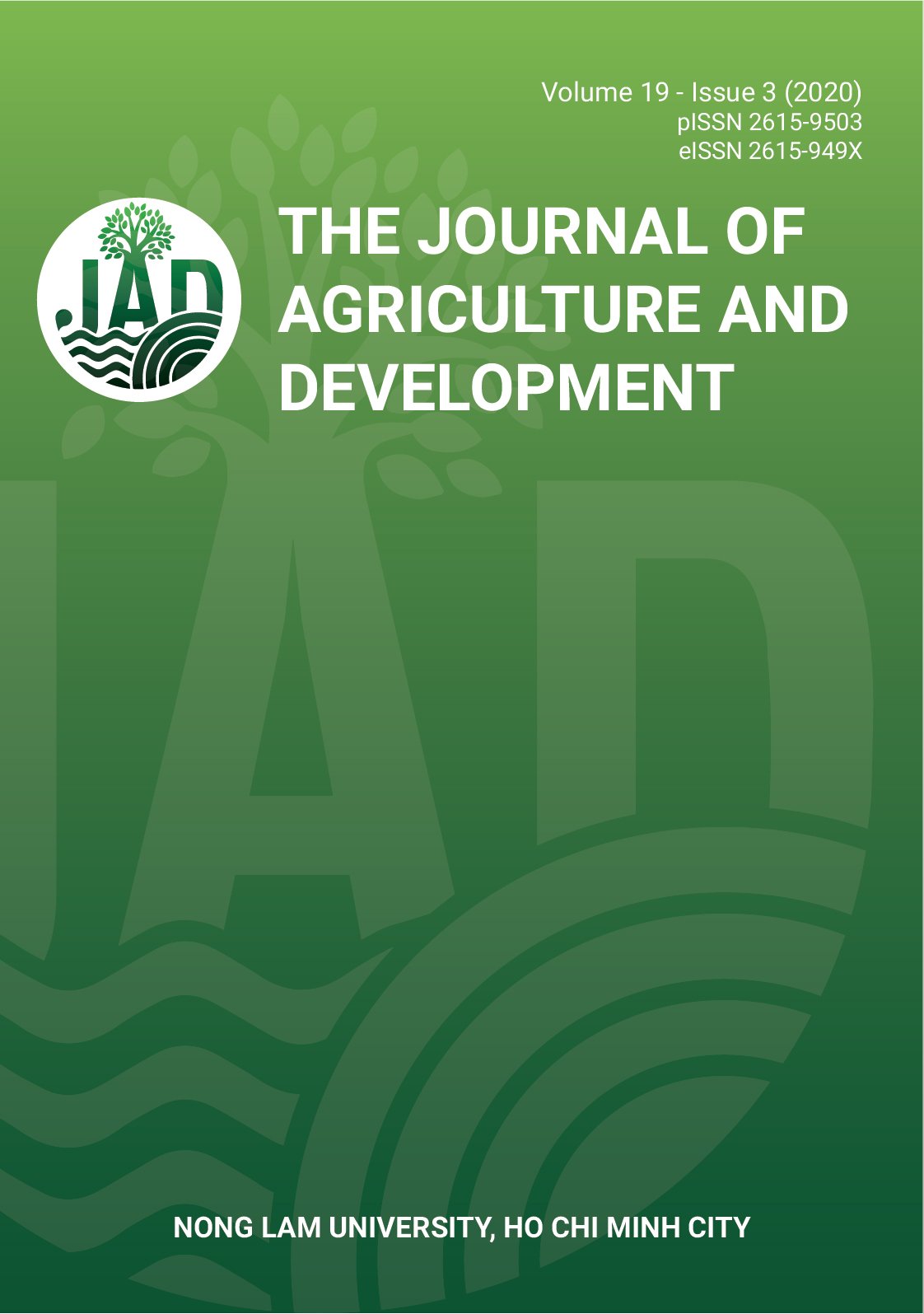Serological survey on Leptospirosis of cattle in Cu Chi, Ho Chi Minh City
Main Article Content
Abstract
Leptospirosis is a zoonotic disease of global importance, especially in tropical countries. The purpose of this study to evaluate the seroprevalence of Leptospira in cattle in Ho Chi Minh city. Serum samples from 446 animals were tested by microscopic agglutination test (MAT) using a panel of 24 Leptospira serovars kits provided by Ho Chi Minh City Pasteur Institute. Results showed that seroprevalence of Leptospira at herd-level was 61.54%; and at individual-level was 31.17%. In which, the percentage of beef cattle (29.77%) infected with Leptospira was lower than that of dairy cattle (31.75%). Cattle from 2 to 3 years of age had the highest rate of Leptospira infection in was 37. 72%. According to herd size, the results found that medium-scale farming (from 25 to 50 animals) had the lowest seroprevalence rate with Leptospira spp. (28.65%). No significant differences were found among aged groups of cattle. There were a totally 7 serovars that were detected in cattle, in which, the two most popular serovars were L. Hardjo bovis (31.37%) and L. Hebdomadis (30.26%). There were twelve animals infected with four Leptospira serovars (8.63%); meanwhile, the majority of animals infected with one serovar were 42.45%. The ratio of positive animals at antibody titer of 1:200 was 53.70%. These results indicated a very high exposure of Cu Chi cattle to Leptospira spp. which consequently posed a definite risk for people working with cattle acquiring this zoonotic infection.
Article Details
References
Adler, B., & Adela, P. M. (2010). Leptospira and leptospirosis. Veterinary Microbiology 140(3-4), 287-296. https://doi.org/10.1016/j.vetmic.2009.03.012
Bahlibi, W. S. (2015). Assessment of major reproductive problems of dairy cattle in selected sites of central zone of Tigrai region, Northern Ethopia (Unpublished master’s thesis). Mekelle University, Mekelle, Ethiopia.
CDCP (Centers for Disease Control and Prevention). (1997). Case definitions for infectious conditions un-der public health surveillance. Morbidity and Mortality Weekly Report 46.
Costa, F., Hagan, J. E., Calcagno, J., Kane, M., Torgerson, P., Martinez-Silveira, M. S., Stein, C., Abela-Ridder, B., & Ko, A. I. (2015). Global morbidity and mortality of leptospirosis: A systematic review. PLOS Neglected Tropical Diseases 9(9). https://doi.org/10.1371/journal.pntd.0003898
Cousins, D. V., Ellis, T. M., Parkinson, J., & McGlashen,C. H. (1989). Evidence for maintenance hosts for Leptospira interrogans serovar hardjo. Veterinary Record 124, 872-874.
Ellis, W. A., Olbrien, J. J., Neill, S. D., Ferguson, H. W., & Hanna, J. (1982). Bovine leptospirosis: Microbiological and serological findings in aborted fetuses. Veterinary Record 11, 147-150.
Faine, S. (1988). Leptospirosis. in laboratory diagnosis of infectious diseases: Principles and practice. In Balows, A., Hausler, W. J., Ohashi, M., & Turano, A. (Eds.).Bacterial Mycotic and Parasitic Diseases (344-352).New York, USA: Springer.
Faine, S., & WHO. (1982). Guidelines for the control of leptospirosis. Retrieved March 30, 2020, from https://apps.who.int/iris/handle/10665/37219.
Laras, K., Cao, B. V., Bounlu, K., Nguyen, T. K., Ol-son, J. G., Thongchanh, S., Tran, N. V., Hoang, K. L.,Punjabi, N., Ha, B. K., Ung, S .A., Insisiengmay, S.,Watts, D. M., Beecham, H. J., & Corwin, A. L. (2002).The importance of leptospirosis in Southeast Asia. The American Journal of Tropical Medicine and Hygiene 67(3), 278-286. https://doi.org/10.4269/ajtmh.2002.67.278
Levett, P. N. (2001). Leptospirosis. Clinical Microbiology Reviews 14(2), 296-326. https://doi.org/10.1128/CMR.14.2.296-326.2001
Lilenbaum, W., & Santos, M. R. (1996). Effect of management systems on the prevalence of bovine leptospirosis. Veterinary Record 138(23), 570-571. https://doi.org/10.1136/vr.138.23.570
Lloyd-Smith, J. O., Greig, D. J., Hietala, S., Ghneim G. S., Palmer, L., Leger, J. S., Grenfell, B. T., & Gulland, F. M. D. (2007). Cyclical changes in seroprevalence of leptospirosis in California sea lions : endemic and epidemic disease in one host species?. BMC Infectious Diseases 7, 125-136. https://doi.org/10.1186/1471-2334-7-125
Martins, G., Penna, B., & Lilenbaum, W. (2011). Differences between seroreactivity to leptospirosis in dairy and beef cattle from the same herd in Rio de Janeiro, Brazil. Tropical Animal Health and Production 44(3),377-378. https://doi.org/10.1007/s11250-011-9918-x
Phan, G. T. H. (2016). The rate of Leptospira infection in dairy cows in Ho Chi Minh City (Unpublished bachelor’s thesis). Nong Lam University, Ho Chi Minh City, Vietnam.
Radostits, O. M., Gay, C. C., Blood, D. C., & Hinchcliff, K. W. (2000). Bovine mastitis: Veterinary medicine a textbook of the diseases of cattle, sheep, pigs, goats and horses (9thed.). London, UK: Saunders.
Tran, O. K. (2016). The rate of Leptospira infection in dairy cows in Hoc Mon and Cu Chi districts, Ho Chi Minh City (Unpublished bachelor’s thesis). Nong Lam University, Ho Chi Minh City, Vietnam.
WHO (World Health Organization). (2011). Weekly epidemiological record (WER). Retrieved March 30, 2020, from https://www.who.int/wer/en/.








